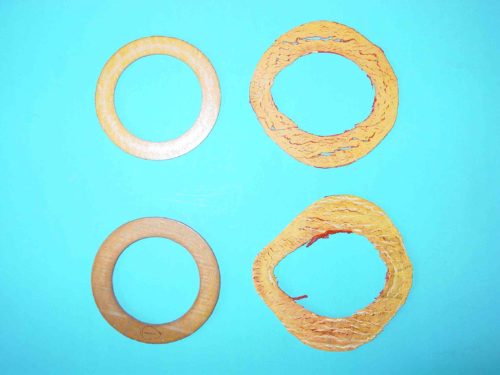MPRC’s Bio-Fuel “science project!”
Leave a CommentMPRC Bio-Fuel Test
To cover our recent test and findings, we need to briefly identify what a Bio-Fuel is:
Bio-Fuels- unlike other renewable energy sources, come from biomass such as plant or animal waste. A Bio-Fuel comes from the conversion of this waste into a liquid fuel, used to meet transportation fuel needs. There are two common types of Bio-Fuels: Ethanol and Bio-Diesel.
Ethanol: A Bio-fuel as it is normally made from corn, although sugar cane is also used, mostly in South America. Blended with gasoline, it increases octane and cuts down carbon monoxide and other smog-causing emissions.
Bio-Diesel: Combined with alcohol, it is a liquid fuel produced from renewable sources such as new and used vegetable oils and animal fats or cooking grease, and is a cleaner-burning replacement for petroleum-based diesel fuel. It’s also non-toxic and biodegradable, and is a cleaner-burning fuel than diesel, eliminating much of the particulate matter that goes out of the exhaust including hydrocarbons, carbon monoxide, and others. Bio-fuels also give a cleaner burn over regular gas, although they do emit about the same amount of CO2 as gas.
Simply put- you can’t use just any O-ring or rubber material when it comes to Bio-Fuels. For example, the aggressive, contaminated Bio-fuel attacks hydrocarbon rubbers such as nitrile rubber, widely used in fuel handling hose, gaskets, and seals. MPRC recommends selecting a Viton Fluoro-Hydrocarbon Elastomer (FKM) for Bio-Fuel service. Of all the testing of various Viton compounds in Bio-Fuels, results have shown that Viton has excellent compatibility with Bio-Diesel (both fresh and contaminated), and has a high resistance to permeation and chemical attack by alcohol, pure ethanol, and blends of ethanol with hydrocarbon fuel.
Just the other day, the team at MPRC was discussing Bio-Fuels and the effect that Bio-Fuels have on Elastomers. Then I remembered something really neat that we did years ago, that I hoped was still around- somewhere. Much to my surprise, it was!
In 2008, we started a test on some O-rings and grommets designed and formulated in our yellow Viton “B” compound. We had acquired some Bio-Diesel from a local company that is unfortunately no longer in business, but they used to offer classes on how to produce Bio-Diesel and even sold equipment to do so.
We decided to place two of our head gasket grommets and a few O-rings into the Bio-Diesel and let it sit- and that we did. I had for the most part forgotten about this, but our discussion earlier this week made me remember. Finally, after sitting in a jar for that long, it was time to remove the items and see how they measured up against the Bio-Diesel.
I don’t know a whole lot of products these days that can say they’ve held up to something like a Bio-Diesel for 14 years- but ours did!
Here are our specific findings:
After removing each item from the Bio-Diesel jar, we carefully inspected and checked the dimensional tolerances. MPRC carefully checked the inner and outer diameter of each item in addition to the overall hardness of each material. To our surprise, ALL of the items remained well within the proper dimensional tolerance/spec. Not only that, but on a few of the items, you can still see the “MPRC” that is raised and embossed into the molded ring very clearly and without any distortion. NOTE: There is a small chunk taken out of the more faded yellow grommet. This is not due to anything relating to Bio-Diesel. MPRC removed a small piece of the grommet to send for testing and lab analysis on the original compound.
Call us hoarders of our precious little Bio-Diesel container, but we like to think of ourselves as brilliant scientists who have made an incredible breakthrough. We’re kidding, of course. We think we do a pretty good job of being fluid sealing specialists, however, and doing fun little science experiments like this to see how our products hold up is a lot of fun. Call us today and see how we can assist you with your fluid sealing needs!
800-397-3429
sales@mprcseals.com
**References: “Biofuel Basics”– Office of Energy Efficiency & Renewable Energy, Bioenergy Technologies Office**
Cut gaskets: Gasket swell and selecting the right material
Leave a CommentIn the Engine business, most gaskets fail due to a combination of thermal cycling and improper surface preparation. Surfaces can become scratched, warped, or pitted which doesn’t allow for equal compression on the sealing surface, increasing the failure rate of the material.
Many people spend a lot of time searching for the perfect gasket material that they’re told “will do X” or “won’t do” (fill in the blank). When it comes to gasket swelling, however, here’s the thing: ALL GASKETS SWELL to some extent.
There are a lot of companies in the fluid sealing industry that don’t want consumers to know that gaskets actually swell. Others use the occurrence of swelling as a material selling point. At MPRC, our goal is to be your fluid sealing specialist, and we strive to educate our customers on the best-suited materials for their specific applications.
There’s also the question of HOW a gasket is installed. Is the gasket being installed dry, or is there a lubricant that is applied to the sealing surface or the gasket directly? That answer will have a tremendous effect on the service life and performance of the gasket.
MPRC recommends installing our gaskets dry- that is, “as-is” without any RTV Silicone or lubricant added. It is important to remember the friction between a gasket and the flanges must be maintained to create a long-lasting seal. Any wet Silicone or oil destroys that friction and most gasket materials will extrude under load. We do recommend or suggest using a Permatex Aviation Grade adhesive or a 3M #77 adhesive to hold a gasket in place, particularly on vertical applications to help the mechanic by holding it in the place where needed. RTV Silicone applied wet will off-gas volatiles that will compromise the integrity of the elastomers in a gasket and lead to premature gasket failure.
(The gaskets that are shown below- LEFT side, were installed dry and used in test service. The gaskets on the RIGHT were installed using RTV Silicone and used in test service)

MPRC has a series of material designations for a wide variety of engine and exhaust applications within the Rail and Marine Industries. We offer CG1 (our OEM Grade), CG2 (our upgrade), and CGO (our Optimized grade). Each option represents a quality sealing solution based upon a specific price point.
CG1 (off-white) offers a high-temp sealing option to 400°F continuous and 700°F maximum, which is affordable. Some applications do not require the “best of the best” when it comes to material and price points, which makes CG1 a very cost-effective solution.
CG2 (yellow one side/grey opposing side) is another high-temp sealing solution that offers a slightly higher temp rating to 662°F and maximum at 845°F. This material is an upgrade from the standard OEM grade material.
For more product info, please contact us at 800-397-3429 or email our sales team at: sales@mprcseals.com
SPOILER ALERT!!!!
**MPRC will be releasing our 7th Generation of Style 7800 gasket material after further testing is completed. Stay tuned for more updates!**
MPRC Team Member Spotlight: Laura Suttles
Leave a Comment
MPRC Team Member Spotlight:
Laura Suttles- Inside Sales/Customer Service- Master Packing & Rubber Company (MPRC)
Chances are, if you have called Master Packing & Rubber Company, you have most certainly talked to Laura. She’s the pleasant and cheery voice that answers the phone, ensuring your order is heading your way. Many of us call her “Lovely Laura” because she is just that! Laura’s dedication and commitment to customer service are unmatched. Here’s a fun fact: Laura began working at MPRC in 2015. Her first day was on her Birthday! How’s that for a commitment?
Laura is not only the voice you speak to regularly- she is the definition of customer care. From order entry to order processing, shipping status- and all stops in between, Laura keeps things moving and happening, ensuring the team at MPRC is getting your items out the door as quickly as possible. She’s not afraid to walk out into production and say, “This one has GOT to go out right away….TODAY!” and she does it quite often because she understands that serving the needs of our customers is a top priority.
MPRC is incredibly blessed to have Laura on our team, and we know our customers truly enjoy working with her and speaking to her regularly. We have received many emails and comments from customers in the field who have nothing but rave reviews for Laura. Several of our customers have also had the pleasure of meeting Laura at various trade shows such as RSI and the International Workboat Show and stated just how much they appreciate working with her and the level of service she provides.
If you want to get to the “next level” of customer care, find yourself a gem like Laura- but be warned, this gem is NOT for sale!

